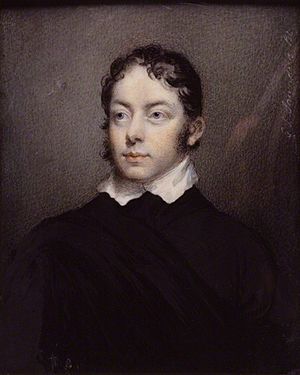Matthew Gregory Lewis facts for kids
Quick facts for kids
Matthew Lewis
|
|
|---|---|

Portrait by George Lethbridge Saunders, c. 1800
|
|
| Member of Parliament for Hindon |
|
| In office 1796–1802 |
|
| Preceded by | James Adams |
| Succeeded by | John Pedley |
| Personal details | |
| Born | 9 July 1775 London, England |
| Died | 14 May 1818 (aged 42) |
| Alma mater | Christ Church, Oxford |
| Occupation | Author |
| Writing career | |
| Language | English |
| Nationality | British |
| Genre | Novels |
| Notable works | The Monk |
Matthew Gregory Lewis (born July 9, 1775 – died May 14 or 16, 1818) was an English writer. He wrote novels and plays that are often called "Gothic horror." This means they were scary and mysterious, often set in old castles or dark places. People often called him "Monk" Lewis because of his very popular novel, The Monk, which came out in 1796. Besides writing, he also worked as a diplomat, a politician, and owned land in Jamaica.
Contents
About Matthew Gregory Lewis
Early Life and Family
Matthew Gregory Lewis was born in London, England. His parents were Matthew and Frances Maria Sewell Lewis. His father was a lawyer and worked for the government in the War Office. His mother was a popular lady in society. Both sides of his family had connections to Jamaica.
Matthew was the oldest of four children. He had three younger siblings: Maria, Barrington, and Sophia Elizabeth. His mother was very supportive of his writing career. She even became a published author herself later on.
His Education
Matthew Gregory Lewis started school at a place called Marylebone Seminary. There, he learned many subjects, including Latin, Greek, French, writing, and drawing. He even had to speak only French during the day!
Like his father, he later went to Westminster School when he was eight years old. He enjoyed acting in school plays there.
At age 15, he went to Christ Church, Oxford, a famous university. He earned his bachelor's degree in 1794. While studying at Oxford, he spent a lot of time in Germany. There, he worked as a diplomat and met famous writers like Johann Wolfgang von Goethe.
His Career as a Writer and Diplomat
Matthew Gregory Lewis spent many of his school breaks traveling. He studied modern languages, which helped him prepare for a career in diplomacy, like his father. He visited places like Paris and Weimar, Germany. During these trips, he loved meeting new people and being part of society.
He also started writing his own plays and translating other works. In 1791, he wrote a play called The Epistolary Intrigue, but it was not performed. He also tried to write a novel.
In 1794, he got a job as a diplomat at the British embassy in The Hague, a city in the Netherlands. He found it a bit boring there. But during this time, he wrote his most famous novel, The Monk. He wrote it in just ten weeks!
The Monk was published in 1795 and made him famous very quickly. It was a scary and exciting story. Some parts of the book were considered shocking at the time. When a second edition came out, Lewis removed some of these parts. Even famous poets like Lord Byron talked about his work.
Later Life and Travels
Lewis also wrote plays for the stage. One of his plays, The Captive, was performed in 1802. It was a very dark and scary play about a woman trapped by her husband. It was so frightening that it was only performed once!
Matthew Gregory Lewis owned large pieces of land in Jamaica. These lands were worked by enslaved people. In 1817, he became the sole owner of more than 500 enslaved people.
In 1816, he visited the famous writers Percy Bysshe Shelley and Mary Shelley in Switzerland. He told them five ghost stories, which Shelley wrote down.
In 1818, Lewis visited his lands in Jamaica. Sadly, on his way back home, he became sick with yellow fever and died on the ship. He was buried at sea.
After he died, his writings were collected and published. His unfinished first novel was called The Effusions of Sensibility.
Works
Novels
- The Effusions of Sensibility (unfinished)
- The Monk: A Romance (1796, revised 1798)
- The Bravo of Venice (1805)
Poems
- Poems (1812)
- The Isle of Devils (1816)
Translations
- Feudal Tyrants; or, The Counts of Carlsheim and Sargans. A romance (1806)
- This was a free translation of a German book by Benedikte Naubert.
Short Stories
- "My Uncle's Garret Window"
- "Oberon's Henchman or The Legend of the Three Sisters"
Collections
- Tales of Terror (1799)
- Tales of Wonder (1801)
- Romantic Tales (1808)
Plays
- Village Virtues: A Dramatic Satire (1796)
- The Castle Spectre (1796)
- The Minister: A Tragedy, in Five Acts (1797)
- The East Indian: A Comedy in Five Acts (1800)
- Adelmorn, the Outlaw (1801)
- Alfonso, King of Castile: A Tragedy in Five Acts (1801)
- Rugantino (1805)
- Adelgitha; or, The Fruit of a Single Error. A Tragedy in Five Acts (1806)
- One O'Clock, Or, The Knight and Wood Daemon, A Grand Musical Romance (1811)
- Timour the Tartar (1811)
- The Captive
Non-fiction
- More Wonders: an heroic epistle to M. G. Lewis (1801)
- Journal of a West India Proprietor Kept during a Residence in the Island of Jamaica (1833)
- The Life and Correspondence of M. G. Lewis (1839)
Images for kids
Sources
- Leigh Rayment's Historical List of MPs
See also
 In Spanish: Matthew Lewis para niños
In Spanish: Matthew Lewis para niños


